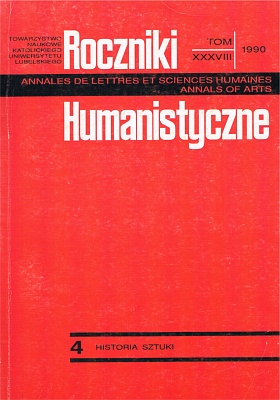The Symbolism of the Old Testament Motifs in the Polish Baroque Embroidery
Abstract
In the period of Baroque the church art drew on the ancient tradition of the Middle Ages which tradition concerned the topographic cycles in which every symbol of Christ’s deed and a scene from His life have been juxtaposed with a corresponding prefigure from the Old Testament. Artistic images of the entire scenes, single figures and objects of devotion from the Old Testament occur in painting, sculpture and above all in artistic craft. The Old Testament compositions appear on liturgical utensils and vessels, they also occur on tapestry and other materials employed to decorate the interior. Embroidery is nothing short of this theme, of which evidence can be found in the preserved buildings, less numerous in Western Europe, but very popular in Poland, though. The theme of the Polish church embroideries is based on the symbols and prefigures found in the texts of the Bible. The embroideries appeared in the beginning of the eighteenth century, and their particular development, along with a broad expansion of the symbolic presentations, took place as late as the second half of that century. In the embroidery of that period there prevail embroideries produced beyond the guild, in religious workshops, far away from the great cultural centers. These provincial works of art, whose technical incompetence and naivety of presentations can be found fault with, bear an emotional expression and profound contents, that is to say, the properties which are often hardly found in the works made accurately by professional craftsmen. The liturgical apparatus kept at the treasury of Jasna Góra belongs to exceptional achievements in this sphere. It consists of a cape, chasuble and two dalmatics made in the years 1720-1725 in the workshop of grey sisters in Mienia in the Podlasie. It comes from the foundation of Michał Krasowski. One can find the embroidered scenes from the Old Testament and symbols adhering to the Person of Christ and the Mother of God also on the set of liturgical vestments kept in Cracow monasteries of discalced Carmelites, Poor Clares, Dominicans as well as on single paraments, most often chasubles, in many churches in Poland.
Particularly interesting for our considerations here is the group of embroideries produced in the second half of the eighteenth century in manorial workshops in Krasiczyn and Dukla. The products of these provincial embroidery workshops, which worked under the patronage of Ludwika Potocka − Krasiczyn, née Mniszech, and Amalia Mniszchowa − Dukla, née Brühl. At present they are scattered over various churches and museum in Poland. They show a specific programme as far as their contents are concerned in which instead of the whole scenes and figures from the Old Testament there was introduced a lavish set of symbols which represented the offerings offered in the temple of Jerusalem. They corresponded to the offering made at Mass and to the symbols of Eucharyst. In order to present the offering objects and accessories one employed drawings from various editions of Scripture, among other things, from the so-called Bible of Leopolita. The illustrations which the artists chose were, after some simplification and remodelling, used in embroideries. One can discriminate two main compositional--iconographic schemes in the whole set of embroideries, which adorn liturgical paraments. In one of them one can see well-exposed, in the middle pillars of chasubles, Eucharistic symbols in the form of a chalice with host and a bunch of grapes and sheaves; on both sides there was an abundant choice of the Old Testament offering accessories and utensils as the so-called „bronze sea”, burnt-offering altar, a tablex of the bread of the Presence, the Ark of Covenant and seven-branched lampstand, breastpiece and some small offering utensils like knives, forks and sieves. The above set is presented by the embroideries on chasubles in Krasiczyn, Przemyśl, Kraków, Sandomierz and Kielce. In the second scheme (design) accessories and vessels as used in the Old Testament for offering have been presented in the middle and supplemented by Eucharistic symbols and offering utensils on both sides of chausbles. The central compositional motif is the Ark of Covenant with the tables of the Commandments and a bronze serpent, a vessel with the manna in the form of an ornamented vase, burnt-offering altar, a table of the bread of the Presence and a laver of bronze for washing. The sides contain, however, the motifs of a bunch of grapes and ears of corn, flagons with wine and loaves of bread as well as other small offering dishes. This design is presented by the paraments in Dukla, Przemyśl, Lublin, Kościelec, Trześniów, Kraków and Czarna.
The symbolic motifs embodied in embroideries are organised so as to represent the most important elements of offerings offered in the Old Testament, and their choice and arrangements on chasubles, which are the main liturgical vestment during a priest’s celebration of a mass, was supposed to emphasize a particular significance of Eucharyst. Moreover, in order to enhance the decorative effect, there were introduced some baroque ornamental motifs of twigs and shell- and comb-shaped forms taken from the rococo ornamentation of the eighteenth century.
Copyright (c) 1990 Roczniki Humanistyczne

This work is licensed under a Creative Commons Attribution-NonCommercial-NoDerivatives 4.0 International License.





